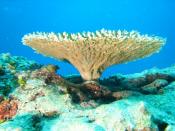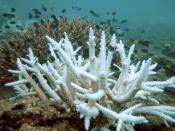Rhythmic waves graze the tops of stony, skeletal bristles of the coral reef. They are underwater rainforests teeming with life in vibrant colors, rooted in the ocean floor. Their bristles peek behind wave crests, hinting at the life below. Just beneath the surface lies a marine paradise in a constant struggle for existence.
This is where existence begins for the coral. Free-floating larvae drift along the oceanÃÂs currents into the open sea. As larvae come to rest in a tropical photic zone, a completely new reef is born. In a few days, the larvae become a small polyp. Its tentacles encircle a primitive mouth sucking down its prey like a garbage disposal. As identical polyps spin off, a new colony begins.
As the polyps multiply, their protective lime stone skeleton grows as well. An inner skeleton forms as each polyp extracts calcium and carbonate from seawater, ensuring the survival of the next generation.
This infrastructure also ensures the survival of a vast community of other creatures living inside the coral. Inside the coralÃÂs flesh reside millions of algae, which in turn, provide a source of energy for growth.
Coral and algae share a symbiotic relationship. The algae extract carbohydrates and fats from coral waste, in exchange for energy the algae extract energy from the sun. This recycling process is a beautiful chemical conversation.
Reef-building corals initiate photosynthesis as sunlight penetrates the waters of clear warm, tropical shallows where coral thrive. Under proper conditions, sunlight can provide millions of microscopic algae with a source of light energy for conversion of chemical energy.
Ninety-eight percent of the coralÃÂs food comes from algae, the tiny plants that make a reefÃÂs existence possible. Through evolution, coral have adapted to harbor its algae. Like all plants, algae are sensitive to sunlight. Horizontal extension allows the...



Great!
written correctly about how the coral reef is a huge part of our ecosystem and has cites listed.
1 out of 1 people found this comment useful.